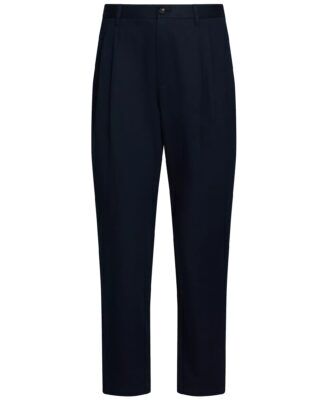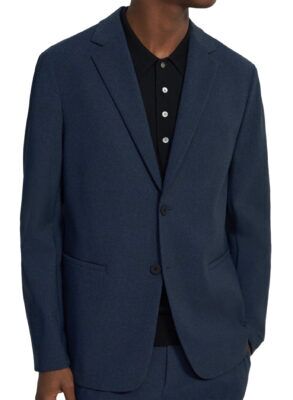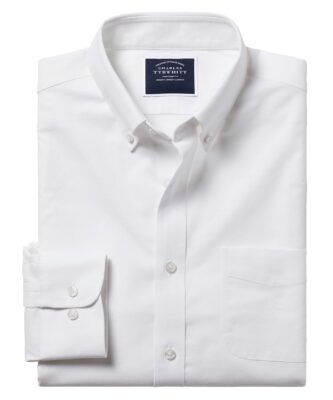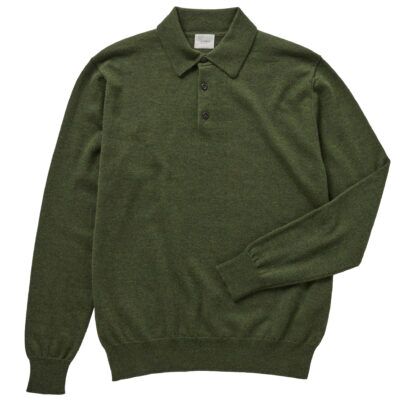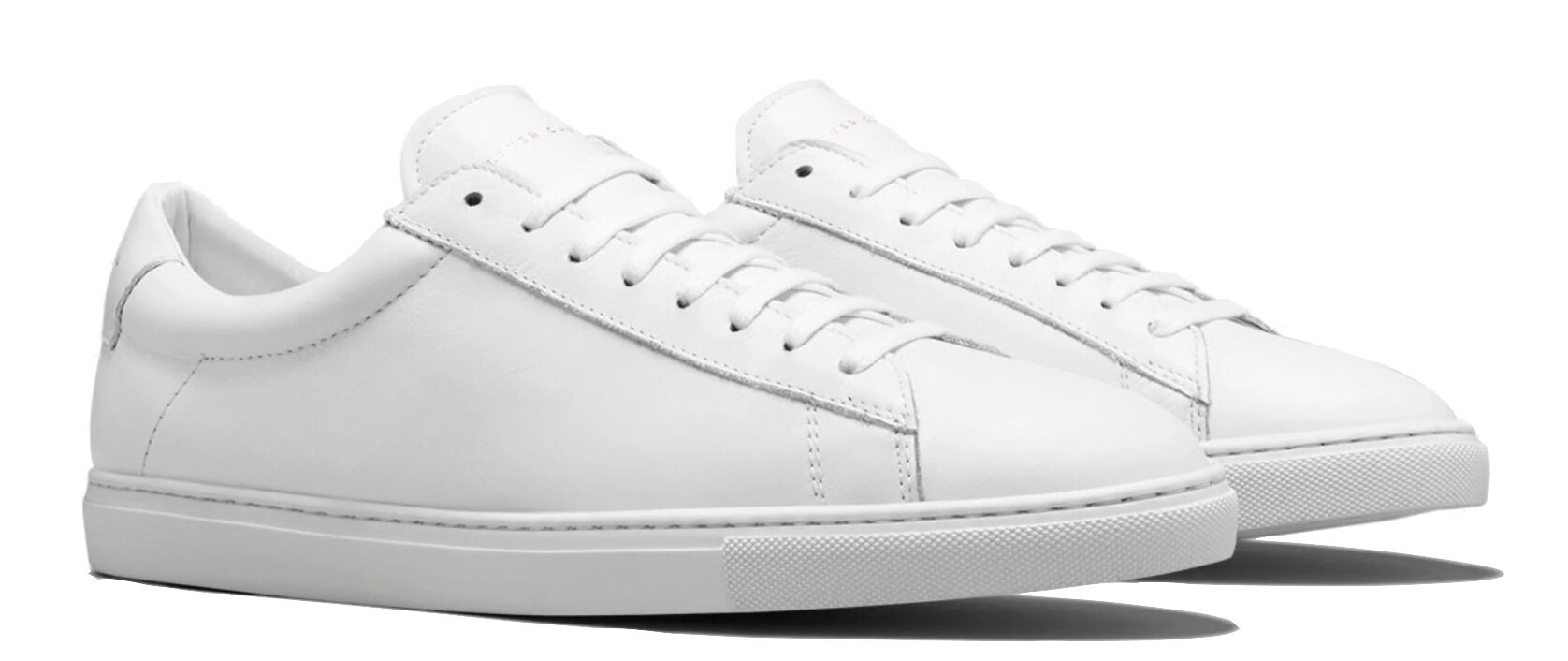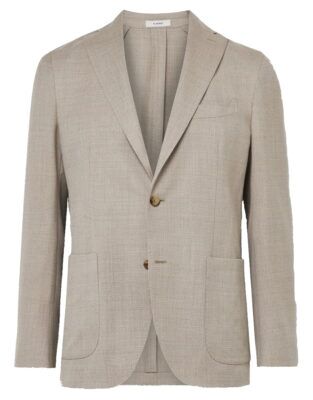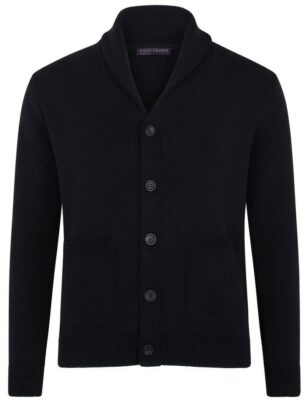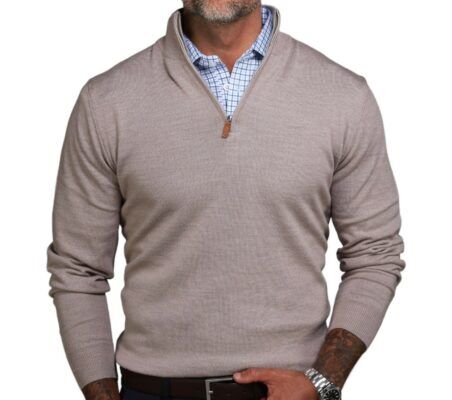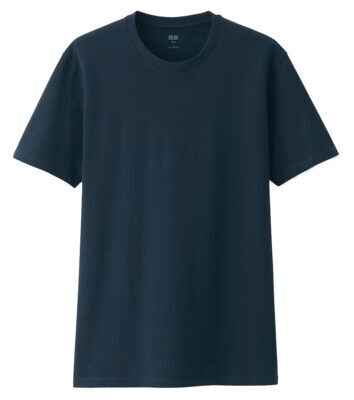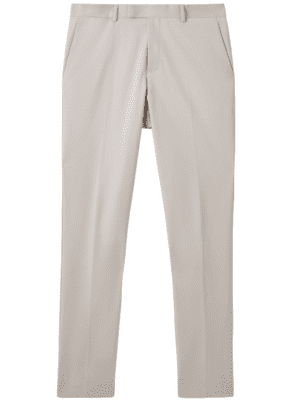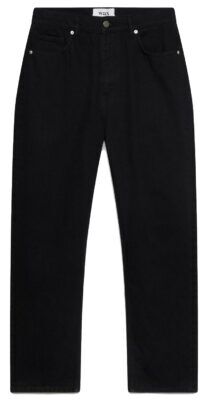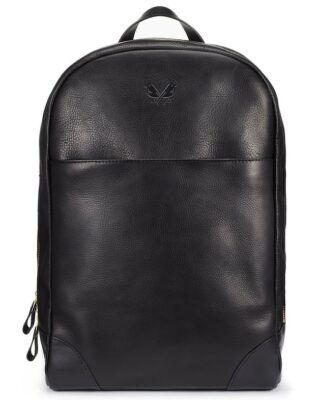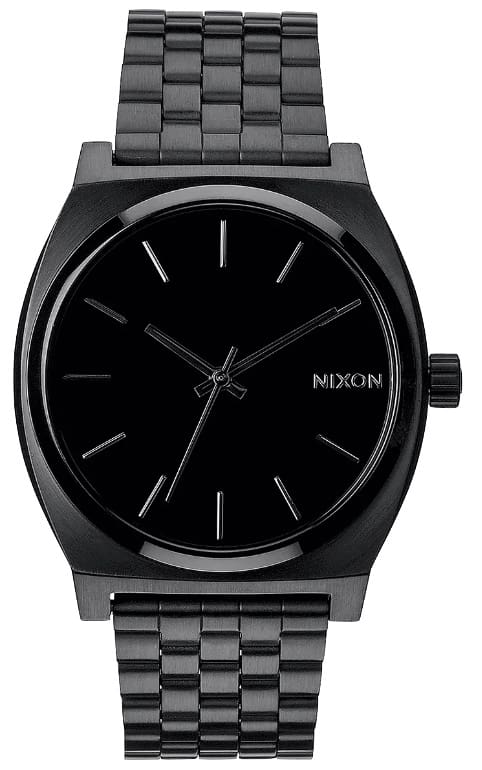Business Casual is an album by Canadian electro-funk duo Chromeo. Confusingly, men’s business casual is also a dress code – one that is as baffling as its inherently contradictory moniker. Business isn’t something that you want to be casual about. Which oxymoron came up with that not-too-smart idea?
“Business casual for men is one of those nonsensical dress codes, like smart-casual, that created bewilderment before it did anything to make people feel more at ease,” says Josh Sims, author of Men of Style. “On the plus side, it helped change attitudes to how men could or should dress at (white collar) work, prefiguring the breakdown of office dress codes over the past couple of decades, especially since the tech boom.”
In a world where Facebook boss Mark Zuckerberg can rock up to the office in jeans, a T-shirt and sliders, the very concept of business-casual can seem as relevant as Myspace. But just because you can wear a hoodie, doesn’t mean that you should – certainly not in the last bastions of formality like finance. You still ought to dress up – just not as far.
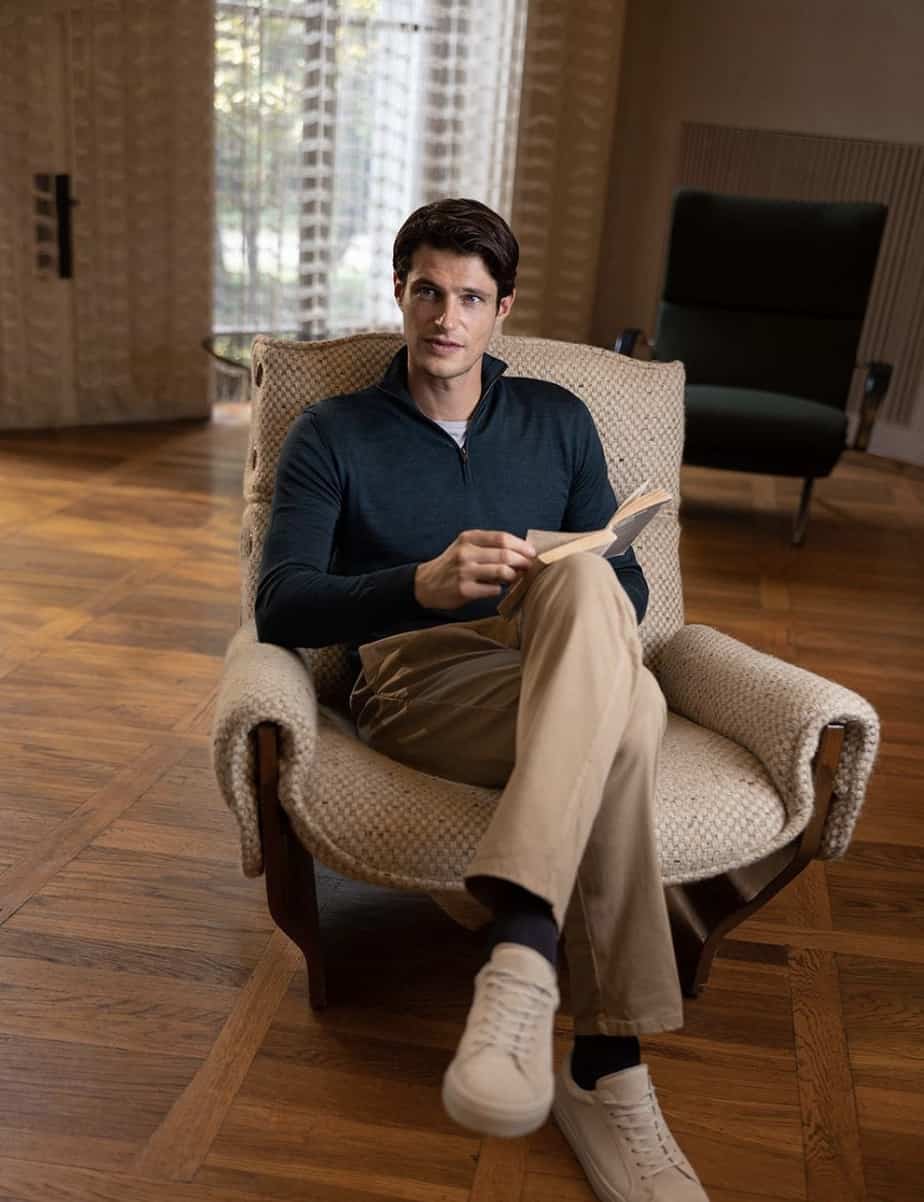
5 Key Pieces For Business-Casual Attire For Men
Chinos: Tommy Hilfiger Pleated Chino
Business-casual has come a long way since Dockers wrote the pamphlet on it, but chinos – or ‘khaki pants‘ as our American friends call them – are still a mainstay.
Unlike jeans, which have their origins in blue-collar workwear and can appear too casual, chinos, from military uniform, are almost never out of order.
Ironically, one of the exceptions is light colours like khaki; darker legwear is not only dressier and safer but also slimming and elongating. Pleats, creases (only down the middle, mind) and a trouser-style tab closure all skew dressier, whereas rolling them up will do the opposite.
Unstructured Blazer: Theory Unstructured Blazer
The suit might no longer be ubiquitous, but it remains the international sign of ‘at work’. Nevertheless, business casual men don’t just lose the tie but cut off the same old two-piece.
“Even stiff professions like banking and law are ditching the canvassing and padding in favour of something much softer,” says Sims.
A blazer is more casual than a suit, and an unstructured one even more so, especially versions that are nubby or knitted, in a scrunchy technical fabric or even sweatshirt-style jersey. Almost more ‘jacket’ than ‘tailored’, they can give even T-shirt, jeans and trainers a business-like veneer.
Oxford Shirt: Charles Tyrwhitt Non-Iron Stretch Oxford Shirt
The business casual shirt equivalent of an unstructured blazer, the Oxford button-down is an OG of business-casual, and much more harmonious with chinos or jeans than a cotton-poplin Jermyn Street neck brace.
One point to consider when it comes to casual shirts is the soft collar itself: a narrow one looks more contemporary and less preppy, but can be too small for any tie much thicker than a bolo. That’s no big deal if you don’t wear ties (or are a cowboy), but it limits the versatility.
Similarly, if the tails are too short then you won’t be able to tuck it in for dressier looks, but too long then it’ll look very ‘dressy’ when untucked.
Polo Shirt: Velasca Bard Merino Long Sleeve Polo
Like khakis, the polo shirt is the epitome of business-casual, and as such has acquired an unfairly bad rap as the ill-fitting preserve of middle-American managers.
Collared and partly buttoned, it’s somewhere between a business-like shirt and a casual tee but, given its sporting pedigree, probably closer to the latter.
Long sleeves can render the polo more office appropriate, as can upgrading commonplace cotton for a knitted fabric such as merino wool (which is sporty but refined, like Roger Federer). Logos should be restricted to a discreet chest emblem, if anything – the only company you should be working for is your own.
Smart Trainers: Oliver Cabell Low 1s
The cover of satirical tome The Official Silicon Valley Handbook reveals that, even in 1983, “econo-brand athletic sneakers” (actually
Journalist Dylan Jones recently penned an editorial about “white-rimmed trainers taking over our streets” – and Mayfair at that. Where once stood Northampton’s finest is now elevated versions of gym kit. A dark leather or suede upper, sleek profile and clean design lend these pimp sneakers some of the properties (and propriety) of a proper shoe – even more so if you plump for ones without that telltale white rim.
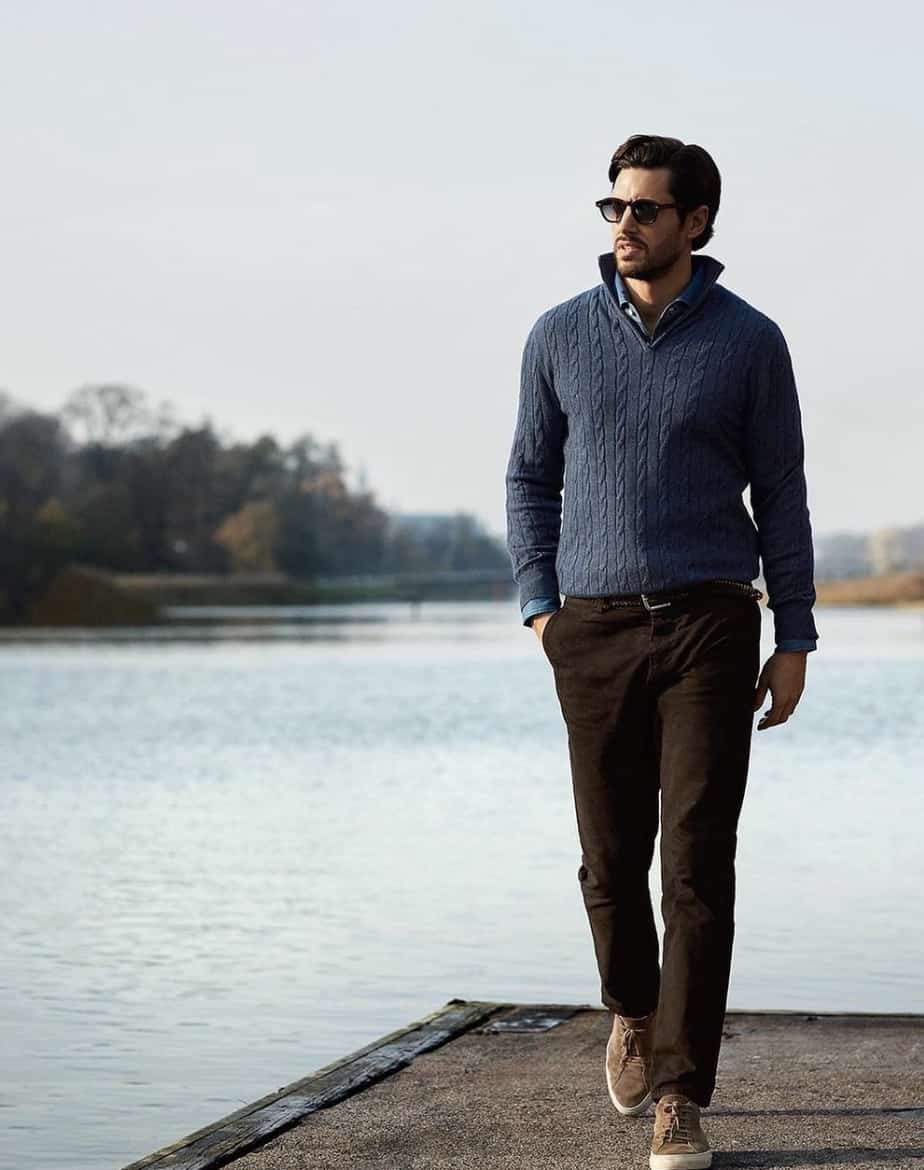
What To Consider When Styling A Business Casual Attire For Men Look: Our Top Tips
1. Restructure Your Officewear
Sure, a blazer worn as a separate is less formal than a full suit. However, keep in mind that a double-breasted, gold-buttoned number is still way too stuffy for smart-casual.
Aim for something more relaxed: unstructured, that is, with little or no padding in the shoulder. A slightly shorter length also reads more casual, not to mention contemporary. Italian brands such as Boglioli, Barena and Aspesi have this game on lock, but you can find solid examples at the premium end of the high street with the likes of
A good unstructured blazer is so soft – made from pliable materials like boiled or Merino wool – that it’s practically a cardigan, and indeed some versions are knitted, or even in jersey. They’re more casual still, but nevertheless smarter than a hoodie.
Take note, Zuckerberg.
2. Jack In Your Jacket
If even the most relaxed form of tailoring feels too uptight, a shawl-collar cardigan is a viable business-casual alternative. Just avoid chunky ribbing, outdoorsy toggles or folksy patterns – you are still there to work after all.
While it’s a different interpretation of ‘workwear’, a chore jacket is a little more like a blazer and therefore smarter than a denim jacket, which can also work, particularly if it’s a dark wash version and not distressed.
With its connotations of military and therefore uniform, a lightweight bomber can do double duty as a blazer. The key here is opting for a dark colour such as navy, in a less utilitarian fabric like wool, cotton or linen instead of the usual shiny nylon.
Note: You might want to balance the casualness of these options out with a smarter button-up shirt rather than a T-shirt, and trousers or chinos instead of jeans.
3. Be A Team Player
Nothing screams ‘catalogue model’ like a V-neck jumper and an open-collared shirt. A crew-neck style is eminently more modern, and sportier. Besides, you don’t need space for a tie. You can even play up the sportswear vibes with a knit that copies the traditional ‘V’ stitched at the collar of a sweatshirt. Or, provided that it’s slim enough, sub an actual jersey sweat for a knit to make your blazer and chinos feel more jock than nerd.
On a similar note, you could also deploy a knitted bomber or zip-up track top. The fabric makes them feel more refined and therefore more formal, while the military/athletic silhouette and hardware gives them – and you – just that little bit of an edge.
4. Dress Down Everyday
In the same way that a rigidly tailored blazer is smart-casual overkill, a stiff-collared Jermyn Street shirt is too, well, stiff. A soft-collared button-down is a much better option, in a fabric such as Oxford rather than shiny poplin.
Again, button-down shirts can look a little bit too stock photo; swapping Oxford cloth for chambray or denim adds a touch of ranch-hand roughness, and visual interest. A grandad or collarless shirt meanwhile looks modern, and not like you forgot your tie. Either way, ensure that your shirt’s tails aren’t too long if you want to wear it untucked.
Falling between a shirt and a T-shirt, a polo is another solid alternative, especially if it’s long-sleeved and in a more premium fabric such as merino wool. This can also be worn under a blazer as an alternative to a traditional button-down.
Then there’s the most casual of smart-casual options – a T-shirt. Finding the right kind to wear with a blazer can be tricky: suitable quality, neither too thick nor too sheer and with a neckline that’s more undershirt than Geordie Shore. If in doubt, stock up on Uniqlo’s excellent, yet affordable, Supima cotton versions.
5. Slack Off (Or On)
The constituent parts of a smart-casual outfit (and the parts of those parts) are like the levels on a DJ’s mixing console. If some are turned right up, then the others should be dialled down to balance everything out – but not so far that they’re out of harmony.
For example, if you’re wearing a blazer, shirt and brogues – tailored trousers might tip the balance too far in the direction of smart. Whereas if you’re wearing a bomber, T-shirt and trainers – tailored trousers can prevent you from looking too casual. Swapping the shirt with a T-shirt, or the brogues with trainers, will also adjust the levels.
In terms of separately tailored trousers, exercise caution with any material that’s too thin or shiny. Something beefier, more textured and less suit-like will lend itself more naturally to being worn with casual pieces and fabrics, such as denim.
In between trousers and jeans, there’s the smart-casual chino. A flat front and roll-ups skew more casual; pleats and creases, are smarter. Tapering will prevent them from looking too dad-like. And thanks to the athleisure revolution, you can now get trousers and chinos with a jogger-style drawstring waist, making them more casual, contemporary and comfortable. These look best with an untucked shirt, polo or T-shirt.
On the other side of the athleisure coin, you can get dressier joggers that are more like trousers with a tailored waistband, no cuff at the ankle and even pleats or creases. But unless your game is tight, and your office dress code lax, play it safe with some actual trousers.
6. Work Some Workwear
Jeans sit firmly at the casual end of the legwear spectrum, but they’re not beyond the pale in a smart-casual workplace – so long as they’re dark (which makes them smarter) and not distressed (ditto).
Most style guides will typically tell you to buy dark blue jeans, preferably in unwashed selvedge denim. They’re not wrong, but blue can sometimes be a bit too sensible. Black is smarter because the stitching and rivets are usually tonal, but they are simultaneously more rock ‘n’ roll. Black and navy is also a surprisingly sophisticated colour combination.
Avoid jeans with too much extraneous detailing and stay off the ripped knee bandwagon; a clean, modern pair will fit more seamlessly into your minimalist, normcore uniform. As with chinos, turn-ups will make any jean, and indeed outfit, instantly more casual.
7. Check The Footsie Index
It’s often the case that the smoother, shinier and sleeker the shoe, the smarter it is, and vice versa. Brogues will therefore put you on a solid, smart-casual footing, but a chunky Derby can look more contemporary and carries a hint of Dr. Martens attitude.
Like T-shirts, trainers can be tricky in a smart-casual context. Helpfully, like with joggers, there are more and more ‘dress’ trainers nowadays: usually combining a dark leather upper with a white sole. White sneakers can look smart, but only if they’re clean – in both a not being dirty as well as minimal sense.
As with any shoe, the other consideration is sleekness. Trainers are already inherently casual, so while you can get away with a chunky dress shoe, a high-top will be way too informal. Styles with minimal branding and stitching (which can quickly discolour) toe the smart-casual line (or hyphen) perfectly.
8. Pack Up
A soft leather briefcase could work with any of the above looks. However, where a backpack might be too junior in a formal office, in a smart-casual workplace it’ll look more on-message than a messenger bag. Get a grown-up one in a dark colour, perhaps in leather to make it feel smarter, and with some decent hardware (i.e. sturdy zips).
If you’re a man who has to flip-flop between the smart and casual sides of smart-casual, a growing number of brands are offering hybrid carriers than can switch between different styles, or look for a bag that can be carried by a top handle to appear more like a briefcase or tote bag.
9. Clock On
A handsome watch with a metal bracelet will elevate the most dressed-down ensemble – even T-shirt and jeans. Not only is it sportier and therefore more casual than a leather strap, but the sheer expanse of shiny metal gives your informal getup some much-needed sheen.
Equally, you could try a Milanese mesh strap, which sits somewhere between a bracelet and leather strap in smartness, and will have a similar effect. No matter if your wrist candy is just quartz.
Common Business-Casual Dos & Don’ts
| Do | Don’t |
|---|---|
| Wear Workwear Puffer vests and structured pants are welcome, but leave the Carhartt overalls at home. |
Wear ONLY Workwear Avoid any well-used items with tears or stains. |
| Be All Business If in doubt about jeans, wear chinos or trousers; if in doubt about trainers, wear shoes. You can always take a tie off, but you can’t pull one out of thin air. |
Be All Casual Enduring the inevitable quips about having a job interview because you’ve dressed too smartly is better than having to go to one because you haven’t. |
| Dress Appropriately Legendary designer Sir Hardy Amies defined businesswear by saying, “I suppose it really depends on what your business is.” A start-up will be far less rigid than a law firm. |
Dress Like A Worker Drone Amies later undermine that by adding: “To be serious, it obviously means a suit made in a dark cloth, and a shirt and collar.” We respectfully disagree, sir. |
| Nail Your Presentation If you’re wearing casual pieces such as a T-shirt and trainers, they should be pristine and not worn, stained or anything you slob around in at home. |
Get Ink On Your Sleeve Yes, times have changed, and this applies more to barristers than baristas, but think twice before unbuttoning your cuffs and uncovering your tattoo ideas. |
| Mix Textures Worsted-wool business suits, poplin shirts and silk ties are smooth and shiny; the same items in coarser, matte fabrics have a different, more casual feel. |
Mix Business & Athleisure Sporty polo shirts, trainers and crew neck sweatshirts (not hoodies) can work, but not anything that you might work out in. Mamil toe is a HR issue. |
| Change Your Working Patterns Like coarse textures and light colours, patterns typically have the effect of making otherwise smart pieces feel more casual than solid options. |
Wear Pinstripes Unless they’re in a very casual – and ‘fashion’ – outfit (e.g. pinstripe trousers, T-shirt and trainers), they shout ‘business’. |
| Check Your Schedule No meetings with internal bigwigs or external clients? The coast, like your diary, is clear to go more casual. Maybe keep a blazer handy, though, just in case. |
Take A Casual Approach As with open-plan offices, it was assumed that business-casual would increase productivity, but studies suggest that the opposite is true. |
| Add Attachments They’re by no means ‘essentials’ (few fashion items are), but a good metal watch and a leather bag will add some polish to the most casual of rigs. |
Slide Down The Corporate Ladder Slap. Slap. Slap. Slap. Slap. That’s the sound of you walking around the office in flip flops, and slipping down in everybody’s estimation. |
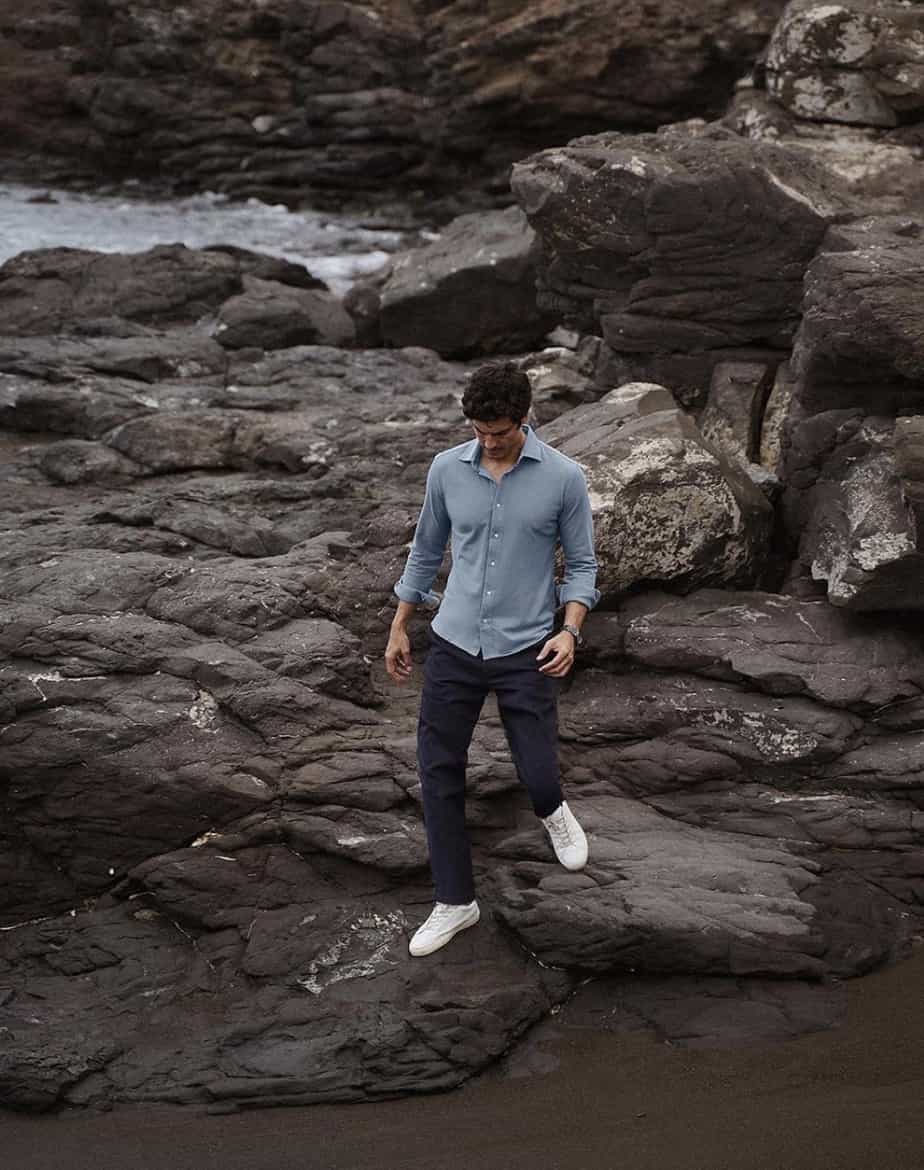
FAQs
1. What is Men’s Business Casual Attire?
Like its name, business-casual in its strictest sense has been a mixed bag. “It simply replaced one uniform (the suit) with another in polo shirts and chinos,” says Sims.
As an ethos, though, business-casual has been all-pervasive, thanks in part to California’s status as a manufacturer of clothing and culture. Then as now, tech companies were perceived as cutting edge; desperate to be seen as adopting best business practices and generally look hip, other companies quickly followed (no) suit.
Men’s business casual is taking over the world. As of 2017, ‘businesslike attire’ for members of parliament at the House of Commons doesn’t have to include ties, and the dress code for leaders at the G8 summit in 2013 was ‘smart-casual’.
Even banks are buying in: JP Morgan introduced ‘business-casual’ in 2016, despite employees’ concerns that they’d look like they had no clients to see. Goldman Sachs, meanwhile, recently instituted a ‘casual’ dress code – but only for its tech staff, and with the caveat: “Please exercise judgement in determining when to adapt to business attire as circumstances dictate, particularly if you have a client meeting.”
2. How Business-Casual Attire For Men Was Born
Business-casual was born in Silicon Valley in the 1980s. It was the product of small, self-contained, predominantly male companies that prioritised results rather than process, and spent more time in front of computer screens than other humans.
“Business-casual was a characteristically American idea to inculcate a work culture of inclusivity,” continues Sims. “Yes, the boss might be better dressed than you day to day, but at least on one day of the week (‘Dress-Down Friday’) everybody got to dress as badly as each other.” Out went the suit and in came khakis and polo – if not Hawaiian – shirts.
The roots of Casual Friday have been traced back, possibly apocryphally, to 19th-century Brits who donned tweed suits before catching the train to their country estates for the weekend. Then in 1966, some marketing genius at the Hawaiian Fashion Guild came up with ‘Aloha Fridays’, which helped the notion of in-office informality germinate.
Capitalising on the growing resistance of employees to traditional suits, and corporations to floral shirts, in 1992 the marketing department at American workwear brand Dockers mailed its trusty ‘Guide To Casual Business Wear’ to 25,000 HR managers. That clarified matters – but only to an extent. Even as late as 1995, the Chicago Tribune newspaper was declaring: “Welcome to the confusing world of business-casual.”

